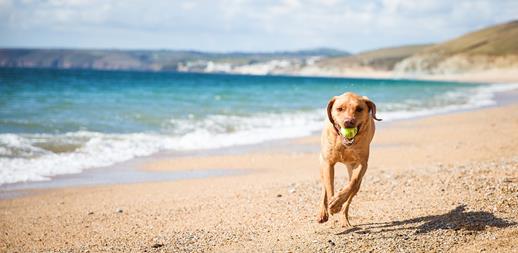
The recent surge in dog ownership means many more of us will be holidaying this year with our dogs in tow. And of course, like us they love a great beach.
All of that space to bolt around, followed by a refreshing splash in the sea. Canine heaven.
Taking your four-legged friend with you to the coast can be great fun, but before you shout ‘walkies’, be sure to check that your beach destination is dog friendly. Dogs aren’t allowed on some beaches, quite often during the summer months, so you need to do your homework before you head off.
To help you in your quest for doggy beach perfection, we’ve rounded up some of the best beaches for dogs from across the UK. These 12 beaches also all feature in the UK Beaches Guide ranking of the top 30 beaches in the UK - so it’s not just your furry friend who will enjoy a sandy day out.
South West England: Woolacombe Beach, Devon
This three-mile long stretch of sand is popular among families and surfers, who are drawn by the unbroken Atlantic breakers and clean water.
Woolacombe village also makes a nice base for a family holiday or stop-over for anyone taking on the South West Coast Path.
Dogs are welcome on the beach all year round, with some restrictions in the summer months.
TOP TIP: Specifically, they’re not allowed in the area between the rocks at the north end of the beach and the stream from Good Friday or 1st April (whichever is earliest) until 30th September[1]. So, even during these months, this still leaves dog walkers with lots of space to explore.
It’s also worth noting that dogs must be on leads from the stream to Mill Rock from the same dates but may be exercised without restriction from Mill Rock onwards.
South East England: West Wittering, West Sussex
Lined with colourful beach huts, this large, sandy expanse of beach is in an Area of Outstanding Natural Beauty.
Located at the entrance to Chichester Harbour, the beach doesn’t feel over-developed, although there are simple facilities such as toilets, parking and a café.
TOP TIP: Again, dogs are welcome, with some restrictions from May to September, during which time they’re not allowed in the Blue Flag bathing zone between groynes numbered 14a to 18, which corresponds to the area in front of the beach huts. They’re welcome elsewhere on the beach during this time[2] and from October to April dogs are welcome everywhere.
South Wales: Rhossili Bay, Glamorgan
The Gower Peninsula is a popular destination for dog-owners in South Wales, with many of its beaches allowing year-round access for dogs. Among the most popular is Rhossili Bay, with its three miles of sand and coastline.
It’s a haven for walkers and dogs are allowed all year round[3].
Northern Scotland: Luskentyre, Isle of Harris
The Isle of Harris in the Outer Hebrides is renowned for having some of the best beaches in Scotland, and even the world.
In fact, Luskentyre Sands, on the west coast of the island, was rated one of the top 25 beaches in the world in a poll for TripAdvisor last year[4].
This dog-friendly beach has miles of white sand, stunning green-blue water and views to the island of Taransay.
North East England: Bamburgh Castle Beach, Northumberland
Dog-friendly all year round, Bamburgh Castle Beach could well be, as Visit England suggests, one of the most atmospheric locations for dog walking anywhere in England[5].
And why is that? Well, because the beach is home to the very spectacular and imposing Bamburgh Castle. It also benefits from rolling sand dunes and views of the The Farne Islands - where puffins, seals and dolphins can be spotted. This beach really does have it all.
Northern Ireland: Whiterocks Beach, County Antrim
The town of Portrush, in County Antrim, Northern Ireland is set on a mile-long peninsula with stunning beaches on either side.
Walkers, water sports enthusiasts and other beachgoers particularly love Whiterocks, a long, wide beach with giant sand dunes - not to mention a backdrop of imposing white limestone cliffs.
GOOD TO KNOW: Dogs are allowed on all of the Beaches in Portrush, however, during busy times they should be kept on a lead or at least in the designated, signposted areas[6].
Southern Scotland: Lunan Bay, Tayside
This secluded beach on the Angus coastline is backed by sand dunes, low cliffs and the crumbling ruin of Red Castle.
While dogs are welcome all year round, there are fragile habitats including resting shoreline birds, so owners are asked to keep dogs under close control around rivers, the estuary, farmland and dunes[7].
GOOD TO KNOW: If you are planning to visit, the one car park (at the North side of Lunan Bay) is usually full by midday on sunny days and most weekends, so it’s worth setting off early!
North Wales: Harlech, Gwynedd
The enormous Harlech beach is part of a National Nature Reserve and is a Site of Special Scientific Interest overlooked by the impressive Harlech Castle, a World Heritage Site.
Beachgoers say it’s a peaceful spot and ideal for children.
GOOD TO KNOW: It’s also dog-friendly all year around, with the exception of a small section of beach in front of the holiday park, which has a dog ban between April 1st and September 30th[8].
Isle of Man: Ramsey Beach
This extensive golden sandy beach is just one minute away from the centre of Ramsey, a coastal town in the north of the Isle of Man.
The beach is bordered on one side by the Victorian Queen's Pier and on the other side by two stone piers. It’s a great spot to watch fishing boats and yachts coming and going while your pup lets off some steam.
GOOD TO KNOW: Dogs are allowed on the northern part of the beach, but not on part of the South Beach from the South Breakwater to the Lifeboat Slipway off Queen's Promenade[9].
North West England: St Bees, Cumbria
Combine a holiday in the Western Lake District with a trip to the coastal town of St Bees.
Dogs are welcome on its mile-long, sandy beach which is the start of the famous Wainwright 'Coast to Coast walk’.
There’s plenty to see for walkers, too. At low tide, rock pools are exposed, as well as an impressive shingle bank. There are also miles of tall cliffs of the red stone that is used for many buildings in Cumbria.
Keep your dog safe in the sun
If you’re hitting the beach on a warm summer’s day, ensure your dog is safe from the heat of the sun. Animal charity Blue Cross reminds beach-goers that dogs – especially those with pale-coloured fur or a sparse coat – are vulnerable to sunburn and therefore skin cancer. It advises dog owners to:
- Keep your pet indoors when the sun is strongest, between 11.00am and 3.00pm
- Alternatively, cover vulnerable areas or regularly apply a non-toxic waterproof human sunblock or a product specifically for pets
- Seek prompt veterinary advice if your dog or cat’s skin looks sore, crusty or scaly
Also, a reminder to never leave your dog in a hot car. Cars can quickly heat up and become life-threatening to dogs trapped inside.
Safe and sound, your dog can have as much fun as you on one of these beautiful beaches – time to get packing.
[1] https://www.woolacombetourism.co.uk/plan-your-visit/dog-information
[2] http://westwitteringestate.co.uk/faq
[3] https://www.swansea.gov.uk/dogsonbeaches
[4] https://www.bbc.co.uk/news/uk-scotland-highlands-islands-54160738
[5] https://www.visitengland.com/experience/dog-friendly-beach-break
[6] https://visitportrush.co.uk/
[7] https://visitangus.com/lunan-bay/
[8] https://www.thebeachguide.co.uk/north-wales/gwynedd/harlech.htm
[9] https://www.visitisleofman.com/experience/ramsey-beach-p1291051


